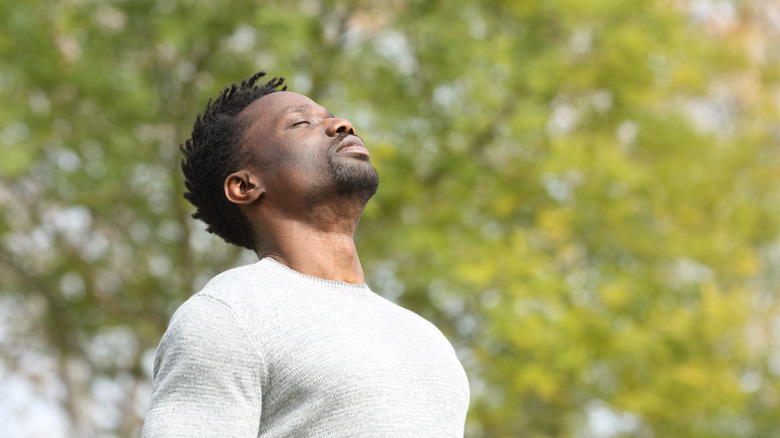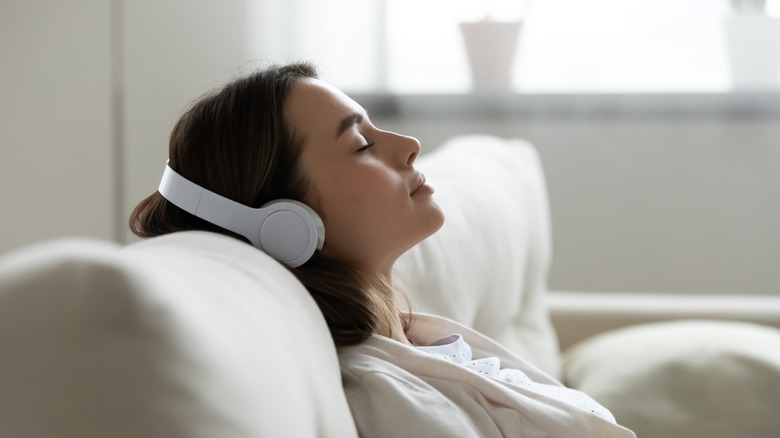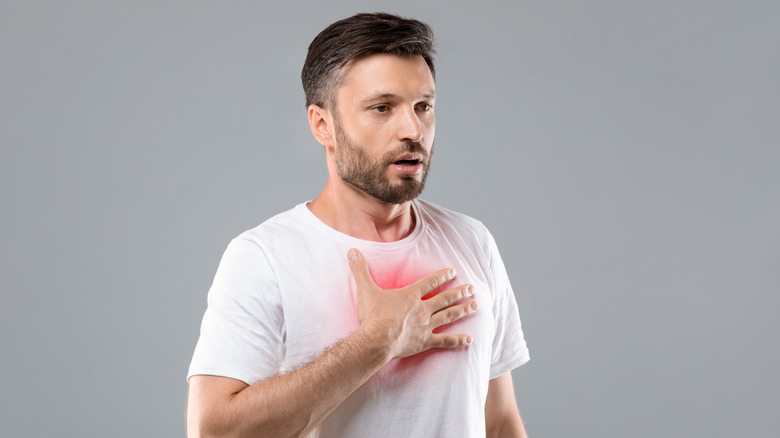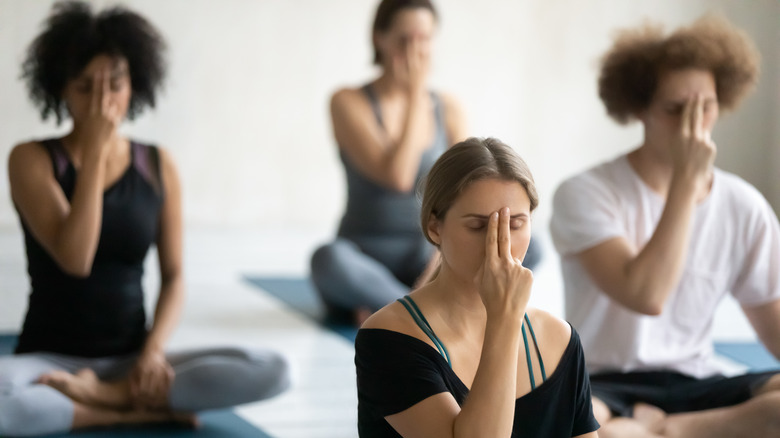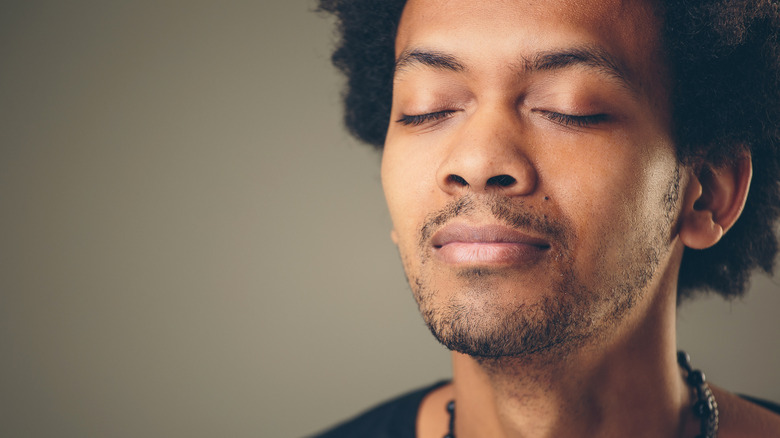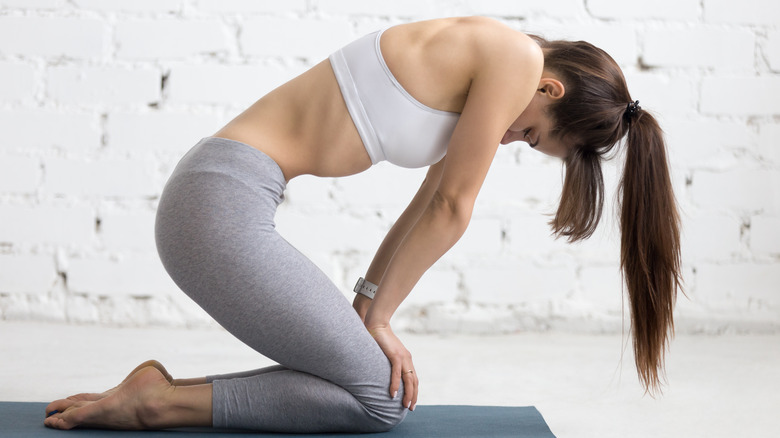What Happens To Your Body When You Practice Breathwork
It may be hard to believe that something as simple and ubiquitous as the breath — a process that's often taken for granted — can have actual restorative effects on your health. There's ample scientific evidence on just how healing mindful breathwork can be (via Frontiers in Human Neuroscience). Breathwork — which refers to the intentional manipulation of breath — has existed across myriad cultures for centuries. And these ancient techniques have been shown to offer up numerous benefits including stress reduction, better immune health, and improved mental health and cognition.
Your breath is the one constant throughout your life. It allows you to create energy through the oxygen you inhale, eliminate waste from the body, sing, scream, laugh, and, well, stay alive (via Scientific American). Because life can be overwhelming and stressful, conscious breathing is an important practice — tapping into the power of your breath will help you self-soothe, become centered, and enhance your well-being. Fascinatingly, a kaleidoscope of changes cuts across your body when you practice breathwork. Read on to discover the science behind this magic.
It reduces stress
Most relaxation or meditation practices involve regulating or focusing on the breath (via Frontiers in Human Neuroscience). After all, breath and emotion are inextricably interwoven. When we're stressed, frightened, or angry, our breathing speeds up and becomes shallow (via University of California, Berkeley). Yet, when we feel safe and calm, our breathing slows down and deepens. And the relationship is reciprocal: The breath can also influence the mind. What makes breathing so unique is that it's both an automatic and voluntary process. Most of the time, we breathe without even thinking about it, but we can also choose to manipulate our breath to shape our state of being.
Studies show that stress relief is a huge benefit of slow, deep breathing with long exhalations (via the Mental Illness Journal). A key explanation for the anxiety-quelling effects of breathwork is its direct impact on the parasympathetic nervous system, which sets off a cascade of bodily responses that help relax your nerves and stabilize your mind. Diaphragmatic breathing, which involves contracting the diaphragm and expanding the belly, lets your brain and body know that there's no danger around and that you're safe (via Frontiers in Psychology). It's been used to treat various mental health conditions and stress-related emotional disorders with positive outcomes. But even a simple breathing exercise can calm you down in seconds.
Your heart rate slows down
When we encounter a scary and intimidating situation, your fight or flight system kicks our heart rate up (via the Cleveland Clinic). One of the ways that breathwork can alleviate stress and serve as an emotional buffer is by slowing down your heart rate. Specifically, taking a slow, deep inhalation with a longer exhalation stimulates the famous though mysterious vagus nerve — the longest nerve in your body and the main component of the parasympathetic nervous system — which governs different bodily functions like your heart rate, respiratory rate, and digestion (via Frontiers in Psychiatry).
Breathwork is a powerful tool for hacking into your autonomic nervous system, claim researchers (via Mental Illness Journal). Controlled breathing sends a signal to your brain to activate your relaxation response: It decreases a rapid heartbeat and racing thoughts and promotes feelings of calmness instead. For this reason, people who experience panic attacks are often prescribed breathing exercises. Breathwork has been touted as an effective non-pharmacological intervention for people with anxiety and panic disorder, helping them manage their symptoms by normalizing their heart rate (via Frontiers in Psychology).
It can make you feel tipsy
While slow, deep breathwork is known for its pacifying effects, some breathing techniques can make you feel intoxicated. When practiced correctly, holotropic breathwork has been known to produce altered states of consciousness, noted researchers (via Psychotherapy: Theory, Research, Practice, Training). The technique has been used for both spiritual and therapeutic purposes. It involves deep, rapid breathing for several minutes, sometimes even hours, which has the potential to cause hyperventilation (via Body, Movement and Dance in Psychotherapy). Some people believe this is essentially what's responsible for that euphoric experience it can yield. This occurs when you exhale too much carbon dioxide (CO2) due to excessive breathing, resulting in plummeting CO2 levels in the bloodstream, accompanied by sensations like dizziness, lightheadedness, and tingling in the body (via the Journal of Transpersonal Research).
Overall, the research is still in its infancy, but there's some scientific and anecdotal evidence that holotropic breathwork can help you overcome stress and increase self-awareness (via The Journal of Alternative and Complementary Medicine). Rapid breathing, though generally considered safe, can feel overwhelming for some people, and has been known to precipitate anxiety attacks due to hyperventilation (via Body, Movement and Dance in Psychotherapy). For this reason, it can be helpful to receive guidance from a trained practitioner or consult with a clinician if something feels off.
It reduces inflammation
One of the fascinating ways that breathwork is said to bump up your immune health is by reducing inflammation in the body (via Frontiers in Human Neuroscience). Inflammation has long been recognized as both a root cause and symptom of many diseases. "There's an intricate connection between the vagus or 'wandering' nerve in your body and your breathing pattern," Aryana Solh, a breathing coach and detox specialist, told Health Digest. "The vagus nerve communicates with the diaphragm, gut, brain, and heart. If your breath is shallow or constricted, it sends a signal of distress and an inflammatory response is created throughout the body."
Research indicates that taking long, deep breaths can send a signal of relaxation instead, which may help reverse or ward off inflammation. People who practiced yogic breathing — also referred to as pranayama — for just 20 minutes had lower levels of stress-related inflammatory cytokines in their saliva than those who didn't practice the technique, according to a study from the journal BMC Complementary and Alternative Medicine. The ancient practice can take various forms (via the Journal of Ayurveda and Integrative Medicine). A common method is inhaling and exhaling deeply and slowly through your nose. It sometimes involves breathing through alternate nostrils, one side at a time. Studies show that yogic breathing can even bring about symptom reduction in serious diseases like cancer (via the BMC Complementary and Alternative Medicine).
It alkalizes your blood pH
Breathwork has many intriguing physiological consequences, one of which includes changing the properties of your blood, in particular, its pH level (via WebMD). Your body is constantly at work to maintain a near-neutral blood pH (via Medical News Today). Although most people's blood is naturally slightly alkaline, certain health problems and even a poor diet or lifestyle can make your pH levels veer towards acidic.
Holotropic breathwork — an almost hyperventilation-type method of breathing — has been said to adjust the balance between carbon dioxide (CO2) and oxygen in the body, which is also known as "respiratory alkalosis," as detailed by a study from the Journal of Transpersonal Research. This is because when you breathe rapidly, you inhale a large amount of oxygen into the body and brain and eliminate CO2. This causes the CO2 content in the blood — which is an acidic molecule — to lessen, shifting your blood to a more alkaline pH. "The situation of people during holotropic breathwork very likely resembles that in high mountains, where there is less oxygen and the CO2 level is decreased by compensatory faster breathing," explained the study author. More research is needed to better understand the mechanisms behind respiratory alkalosis.
It can ease symptoms of depression
Not only can your breath serve as a built-in stress-reliever, but research shows it can help to lift depressive symptoms (via Frontiers in Human Neuroscience). An exercise as simple as exhaling longer than you inhale shifts your body into a more parasympathetic (resting) state, lowering your blood pressure and cortisol levels, which can have an uplifting impact on your mood. A 2020 study found that people who took part in an eight-week breathwork program saw massive improvements in depression, stress, and social connectedness (via Frontiers in Psychiatry). Similarly, participants of a 12-week "coherent breathing" intervention — a type of long, slow breathing — experienced a significant drop in depressive symptoms (via The Journal of Alternative and Complementary Medicine). This correlated with an increase in their levels of gamma-aminobutyric acid — a brain chemical that has calming, antidepressant-like effects.
A breathing-based meditation practice known as Sudarshan Kriya yoga may also relieve symptoms of severe depression and anxiety in people who haven't responded to traditional antidepressant medication, according to a study from the Journal of Clinical Psychiatry. The practice consists of a series of rhythmic breathing exercises, namely slow, deep breaths alternated with fast, invigorating ones, which can bring about a peaceful and meditative state.
It helps you fall asleep better
Your breath can be a valuable companion when insomnia strikes. Even a 20-minute slow-breathing exercise could help solve your sleep woes, based on the findings of a study from the journal Psychophysiology. People who used a relaxing breathing technique before bed each night fell asleep faster, woke up less frequently throughout the night, and went back to sleep much quicker than insomniacs who didn't practice breathwork. It took the participants around 10 minutes, on average, to doze off — almost three times faster than others.
In fact, slow, deep breathing might be even more effective at combating insomnia than most sleeping pills, particularly when used in conjunction with relaxation techniques and healthy sleep hygiene, suggests a 2019 study. Controlled and focused breathing can help you drift into slumber more easily by increasing parasympathetic (vagal) activity and reducing the sympathetic drive. This interrupts the body's fight or flight response before you fall asleep and promotes feelings of calm instead. So it might be worth taking some time out to learn and adopt a few respiratory techniques if you've been dealing with sleep problems.
It can improve your respiratory health
The coronavirus pandemic has taken a huge toll on respiratory health with breathlessness being one of the hallmark symptoms of COVID-19 (via the European Respiratory Journal). Interestingly, research is now validating the therapeutic effects of breathwork on the lungs. A 2018 study showed that people with asthma can use breathing exercises, including diaphragmatic breathing, nasal breathing, slow breathing, and controlled breath, to manage their symptoms and improve their quality of life (via The Lancet).
Some experts even advocate for a controversial therapy known as Buteyko breathing (via Cochrane Library). The method involves taping patients' mouths during sleep to train them to learn how to breathe through their nose. It's been said to improve asthma symptoms and reduce patients' reliance on asthma medication by increasing their oxygen intake and normalizing carbon dioxide (CO2) levels in the blood since it's suggested that low CO2 caused by mouth breathing is essentially what drives asthma pathophysiology.
It can reduce symptoms of post-traumatic stress disorder
A breathing-based meditation practice was able to bring down stress, anxiety, and respiration rates in U.S. military veterans suffering from post-traumatic stress disorder (PTSD), according to research from the Journal of Traumatic Stress. Similarly, a 2019 study found that device-guided slow breathing exercises could help improve some of the physiological symptoms in patients with severe PTSD, such as a skyrocketing heart rate and blood pressure. "A non-pharmacological intervention [such as device-guided breathing] could be beneficial in the treatment of PTSD, especially in severe cases," Monica Vemulapalli, the main author of the study, told ScienceDaily.
People with PTSD often have a hyperactive sympathetic nervous system that they struggle to down-regulate due to deeply rooted trauma, explained researchers (via Dialogues in Clinical Neuroscience). In other words, their bodies are in constant fight or flight mode, which is evident in their higher-than-normal heart rate and blood-pressure readings as well as other psychophysiological measures. Controlled breathwork techniques are a potent way to rebalance and soothe the autonomic nervous system (via the Journal of Traumatic Stress).
It changes your brain
Breathing techniques can create huge psychological and physiological changes in the body. They can even change the size and structure of your brain (via Social Cognitive and Affective Neuroscience). Mindful breathing has been shown to decrease the volume of gray matter in the amygdala, resulting in stress reduction and improved well-being. The amygdala — an almond-shaped portion of the brain that's involved in processing emotion — is activated when you see fearful and unfamiliar faces or when interpreting emotional expressions (via Frontiers in Neuroscience). A study published in PLOS One discovered that the amygdala became smaller after participants attended an eight-week mindfulness meditation course. And as a result, the brain's pre-frontal cortex, which is the area responsible for higher-order functions like concentration and decision-making, became thicker.
The way you breathe can affect how you think and feel by directly impacting neural activity, reported a study from The Journal of Neuroscience. In particular, breathing through the nose sparks electrical activity in limbic-related brain areas such as the amygdala and hippocampus, which are linked to better recall and decision-making. Other studies have detected greater electrical activity in the left frontal, midline, and occipital regions during breathwork which are associated with memory, attention, and learning, lending further support to the idea that regular breathing practices can boost your brain health (via Frontiers in Psychology).
It can help you focus
Anyone who's familiar with meditation will know that the breath is a simple way to guide and anchor the mind. Yogis and meditators have harnessed the power of breath for thousands of years to elevate concentration. And science is now providing evidence that the cognitive benefits of these ancient practices are real. Meditative and yogic breathing techniques like pranayama — which involve breathing slowly and deeply through the nostrils — have been shown to improve arousal levels, reduce mind wandering and emotional reactivity, and increase individuals' ability to focus.
This is because the rise and fall of your breath regulate the brain's production of noradrenaline, details a 2018 study from the journal Psychophysiology. The neurotransmitter fosters the growth of neural connections and helps you pay attention when released at the right levels. Too much or too little noradrenaline can hamper your ability to focus, but the correct levels can optimize mental clarity and attention.
It may improve your emotional intelligence
A lot has been said about the ability of breathwork to enhance cognitive skills. But it appears that changing the way you breathe can improve your emotional intelligence too, conceded researchers. After all, breath and emotions are intimately tied together. In a study published in the journal Cognition and Emotion, the authors observed that certain feelings, such as joy, anger, sadness, and fear, evoked specific breathing patterns. When people felt anxious, their breathing became irregular, shallow, and fast, whereas feelings of joy brought on a slow and steady pace.
By the same token, different rhythms of breathing can elicit different emotional states. For instance, belly breathing, which causes vagal nerve stimulation, can help calm you down and return to a more rational state of mind (via Frontiers in Psychology). So, the more you practice bringing your attention to your breath when feeling stressed out, the better skilled you can become at developing greater emotional awareness and regulation and combatting ruminative thinking.
It can increase your muscle tone
There are many ways to strengthen and tone your body beyond sweating it out at the gym. Regularly practicing breathwork to strengthen your diaphragm — that important muscle that allows you to breathe — can have a positive knock-on-effect on other muscles in your body, noted Penn Medicine. The diaphragm takes care of around 80% of your breathing, which supplies your muscles with the oxygen they need to function and perform properly. A powerful breathing exercise like the "breath of fire" puts your diaphragm to work. It involves passive inhales and active exhales that are quick and stimulating — and this can improve your stamina and durability in sports like endurance running (via Verywell Fit).
Some deep breathing exercises can also be used to relieve physical tension and muscle stiffness in the body, reported University of Michigan Health. And so, it's no surprise that proper breathing is the cornerstone of the training that most elite athletes undergo.
It helps control pain
It's long been known that taking control of your breathing can reduce physical pain (via The Journal of Pain). "Shallow or restricted breathing is an unconscious, learned behavior in response to stress, trauma, and fear," breathing coach Aryana Solh told Health Digest, adding that: "Holding our breath allows us to temporarily de-activate emotions that feel too intense to process the moment in which they arise."
Meditative mindful breathing has been shown to be particularly effective at pain management. But this technique takes time to cultivate. So, researchers have been exploring more accessible and immediate methods, such as, "virtual reality breathing," which is proven to be another effective way to cope with pain, especially for beginners. A 2021 study published in the Journal of Medical Internet Research compared two different approaches: Traditional mindful breathing and virtual reality-guided breathing. In the latter, participants wore 3D glasses and watched a virtual reality model of a pair of human lungs, while mindfully breathing themselves. The results showed that each of these methods helped drive down pain significantly by acting on a part of the brain that processes painful sensations called the somatosensory cortex.
"The way that an individual breathes can completely transform their emotional state in a very short space of time," Solh explained. "Breathwork can help you release pain and trauma, and enter into a state of deep relaxation. Therefore, there is huge power in mastering your breath."



